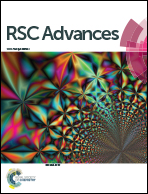Antibacterial amphiphiles based on ε-polylysine: synthesis, mechanism of action, and cytotoxicity
Abstract
The development of antibacterial materials is recently more and more important and urgent due to the emergence of antibiotic-resistant bacteria. To address the problem, series of new amphiphiles based on ε-polylysine (ε-PL) were synthesized by alkylation reaction with alkyl bromide, and concurrently their antibacterial activity and cytotoxicity were evaluated. The amphiphiles with a large concentration of positive charges and lipid chain promoted their adsorption to bacterial membranes through electrostatic interaction and hydrophobic interaction, subsequently killed both Gram-positive (S. aureus and B. amyloliquefaciens) and Gram-negative (E. coli and P. aeruginosa) bacteria. Morphology observed using SEM shows that these derivatives could cause leakage of intracellular contents. Analysis of the antimicrobial mechanism displays that these derivatives against the bacteria started with disruption of the bacterial membrane, which caused the leakage of cytoplasm, and killed the bacteria. Among the amphiphiles, ε-PL-g-butyl2 presented the most effective antibacterial activity and its minimum inhibitory concentration as low as 3.9 μg mL−1. Importantly, the effective antibacterial concentration of ε-PL-g-butyl2 displayed no cytotoxicity against human cells. This work not only highlights the great promise of using ε-PL-g-butyl2 as a highly effective antibacterial agent but also provides the important tool for understanding the interactions between the microorganisms and amphiphiles-based ε-PL.


 Please wait while we load your content...
Please wait while we load your content...